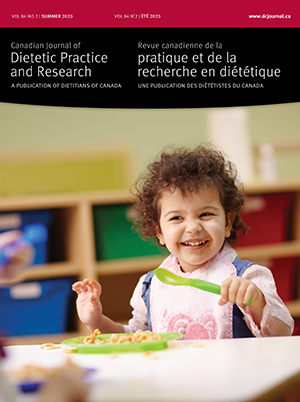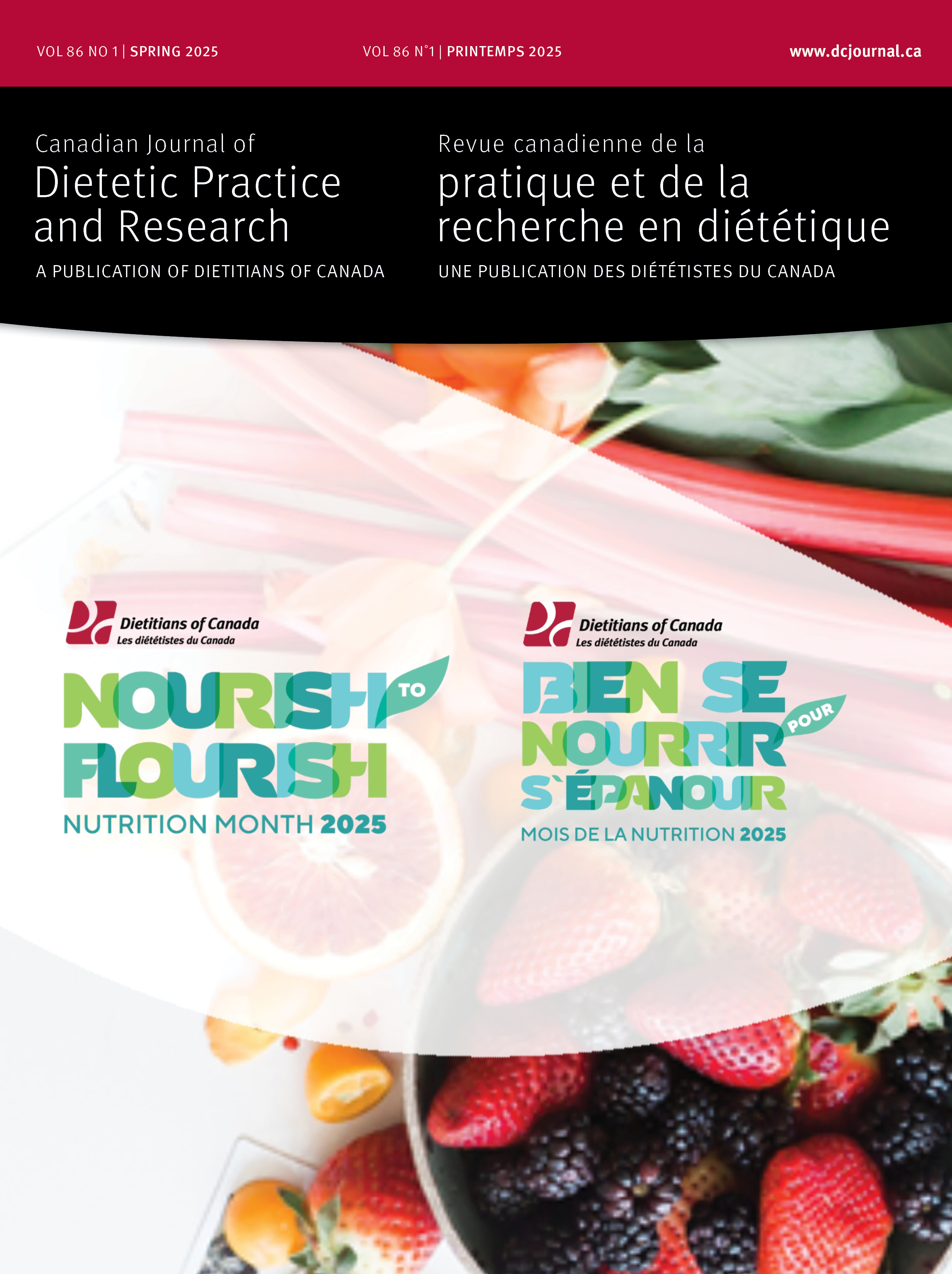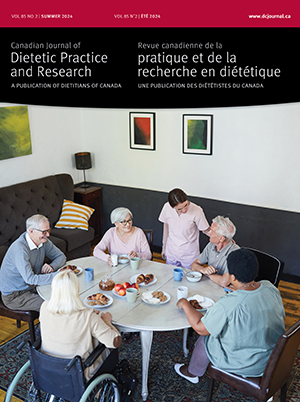Volume 84 • Number 2 • June 2023
Editor’s Message
Research
Purpose: When admitted to the hospital, individuals with celiac disease rely on food handlers for provision of safe, uncontaminated gluten-free meals. We aimed to assess the knowledge of gluten-free diet (GFD) amongst individuals involved in meal preparation for patients.Methods: A questionnaire with 10 demographic and 35 test items to assess knowledge of GFD, including workplace scenarios encountered in meal preparation, was administered to food handlers including cooks, utility workers, dietary technicians, and supervisors in 2 tertiary care, university-affiliated hospitals. A score of ≥28 of 35 (≥80%) was considered a “pass”.Results: A total of 72 individuals completed the study, mean age 40.3 ± 1.6 years, 75% female. Only 42 (56.8%) scored ≥80% and achieved a pass. The average score was 75.9% ± 13.4%, range 25.7%–100%. The supervisors had significantly higher scores (87.9% ± 11.4%) than utility workers (73.0% ± 11.4%; P = 0.01) and cooks (71.7% ± 14.5%; P = 0.01). Cooks had the lowest scores with 80% scoring <80%. Females scored higher than males (77.8% vs. 68.8%; P = 0.02).Conclusions: There are significant differences in GFD knowledge amongst various groups involved in food preparation in hospitals. The gaps identified in knowledge can potentially compromise the safety of patients with celiac disease. Targeted interventions to educate hospital food handlers about GFD are warranted. Registered Dietitians can play an important role in providing this education.
OPEN ACCESS
Purpose: This investigation evaluated food values, food purchasing, and other food and eating-related outcomes during the COVID-19 pandemic in Quebec, Canada. The role of stress in eating outcomes was also examined.Methods: An online household survey was conducted among Quebec adults aged ≥18 years (n = 658). Changes in outcomes during, as compared to before, the pandemic were evaluated using descriptive statistics and thematic analysis of free text responses. Eating outcomes by daily stress level (low, some, high) were assessed using Cochran–Armitage test for trend.Results: Most respondents reported increased importance and purchasing of local food products (77% and 68%, respectively) and 60% reported increased grocery spending (mean ± standard deviation: 28% ± 23%). Respondents with a higher daily stress level had a higher frequency of reporting eating more than usual compared to before the pandemic (low stress 21%, some stress 34%, high stress 39%, p-trend <0.0001). Free text responses described more time spent at home as a reason for eating more than usual.Conclusions: To support healthy eating during and post-pandemic, dietitians should consider patients’ mental/emotional well-being and time spent at home. Moreover, support of local food products may provide opportunities to promote healthy eating, sustainability, and post-pandemic resiliency of food systems.
Introduction: Optimizing women’s diets in pregnancy improves maternal and child health outcomes; however, the best format for supporting women’s nutrition goals in pregnancy is not clear, and access to dietetic services is not standard in prenatal care in Alberta. This study explored women’s perceptions about access to Registered Dietitians (RDs) throughout pregnancy and RDs experiences providing prenatal nutrition counselling.Methods: Two studies were conducted. Study A: Pregnant women completed a short survey while attending a prenatal appointment in a large prenatal clinic. The survey assessed women’s perspectives about accessing dietetic services during pregnancy. Survey data were analyzed using descriptive statistics. Study B: RDs participated in either a semi-structured phone interview or a focus group and described their experiences working with pregnant women. Data were analyzed using thematic analysis.Results: One hundred pregnant women completed the survey. Ninety percent indicated that they had not seen a RD at this time in pregnancy, and 48% reported that they would like to access a RD in pregnancy, if available. Dietitians discussed the diversity of women’s concerns and the challenges to providing prenatal nutrition support.Conclusions: Women have nutrition-related questions during pregnancy. Dietitians experience challenges providing services in the current care systems.
Purpose: Our purpose was to explore the experiences of self-identifying Two-Spirit, lesbian, gay, bisexual, transgender, and questioning (2SLGBTQ+) Canadians in treatments for their eating disorders (EDs). By knowing more about their experiences, we hoped to better understand how dietitians and ED service providers can better support 2SLGBTQ+ clients.Methods: Ten self-identifying 2SLGBTQ+ individuals reporting concerns regarding body image or eating patterns, as well as accessing support services or treatments, within Canada were recruited through social media platforms. Participants took part in semi-structured interviews. Data were recorded, transcribed, and analyzed using thematic analysis.Results: Four themes are presented: (i) feelings of judgement and otherness, (ii) experiencing shame in EDs and 2SLGBTQ+ identity, (iii) perceiving a lack of understanding and knowledge, and (iv) sharing lived experiences with the care team.Conclusions: Increased focus on trauma-informed approaches to ED treatment in 2SLGBTQ+ populations are indicated so that 2SLGBTQ+ clients feel comfortable to share. Increased education in 2SLGBTQ+ terminology and gender expression is recommended for dietetic professionals. We also recommend increased recruitment efforts for more diverse care teams.
Purpose: This study investigated the potential influence of the 2019 Canada’s Food Guide (CFG) on the eating environment and food provided in early learning and childcare centres across Canada.Methods: Directors of childcare centres were invited to complete an online survey about their awareness and adoption of the 2019 CFG and submit their menus for analysis.Results: Twenty-five directors completed the survey, and eighteen cycle menus were analyzed. Frequency and the types of foods offered in childcare centres were assessed. Ninety-two percent reported being aware of the changes in the food guide. Many challenges including the lack of support and resources, cost of food, and food reluctance could affect their ability to apply the changes, especially the incorporation of plant-based protein and the uncertainty around the amount of dairy products to provide. Menu analysis indicated frequency of offering items from the various food groups. Vegetables were mostly offered during lunchtime with an average offering rate of 4.83 ± 0.24 times per week.Conclusion: Representatives of early learning and childcare centres identified having difficulties in interpreting and applying the changes in the 2019 CFG. Dietitians have the knowledge and skills required to support childcare centres through training opportunities, workshops, toolkits, and advocacy.
OPEN ACCESS
Purpose: FoodNOW (Food to eNhance Our Wellness) engaged in assessment of simulated households that include a person living with HIV/AIDS (PLWHA) in Nova Scotia to determine if a basic nutritious diet is affordable.Methods: We used supermarket websites to cost food and beverage items listed in the National Nutritious Food Basket (NNFB) for simulated households, each with a PLWHA. Food costing methodologies were co-developed and adapted with community members in response to barriers presented by the COVID-19 pandemic.Results: We found that simulated households, each with one PLWHA, that had a potential deficit after monthly expenses were a household of four on Income Assistance (−$1,058.70), a lone mother with two children on Income Assistance (−$973.65), a lone man on Income Assistance (−$677.40), and a household of four with one minimum-wage earner (−$383.45).Conclusions: Nova Scotia households with a PLWHA living on Income Assistance or with a minimum-wage earner cannot reasonably afford a nutritious diet in addition to basic household expenses. Using these food costing data can allow dietitians to efficiently inform government action and policy change to improve the health and wellness of individuals and families.
Perspectives in practice
While conducting nutrition/health research into weight changes during incarceration and related determinants, it became apparent that the correctional setting in Canada was unique and required study design modifications to ensure study success. Consequently, we made many methodological adjustments during recruitment and data collection because of unforeseen challenges in the correctional context. This paper provides an illustrative example and shares insights on the challenges faced when conducting nutrition/health research in Canadian correctional facilities. Guidance on how to adapt research methods to make them more conducive to this unique environment is provided. This paper also highlights the importance of conducting nutrition/health research in this setting, especially given the lack of this type of research and the need for more evidence-based data to guide health promotion and nutritional interventions in Canadian correctional facilities.
OPEN ACCESS
Gaps in communication training have been identified in Canadian and international academic and practicum dietetics programs. A workshop was developed to pilot supplementary media training to nutrition students/trainees studying in Nova Scotia. Students, interns, and faculty from two universities participated in the workshop. Data on perceived learning, media knowledge/skill use, and workshop feedback were collected immediately post-workshop using a mixed-form questionnaire. A modified questionnaire was administered eight months post-workshop to obtain information on utility of the perceived acquired knowledge/skills. Closed-ended responses underwent descriptive analysis, while open-ended responses underwent thematic analysis. Twenty-eight participants completed the questionnaire post-workshop, and six completed it at follow-up. All participants rated the workshop positively (7-point Likert scale) and reported learning something new (perceived). Perceived learning emphasized general media knowledge/skills and communication skills. Follow-up data suggested participants had applied perceived media knowledge/skills in message development and media and job interviews. These data suggest that nutrition students/trainees may benefit from supplementary communications and media training and provide a stimulus for ongoing curriculum review and discussion.
Older adults are the fastest-growing demographic group in Canada, and the majority of older adults want to age-in-place within their communities. Many older adults live in naturally occurring retirement communities (NORCs), unplanned communities with a high proportion of older residents. NORC supportive services programs can help older adults successfully age-in-place. One such program is Oasis Senior Supportive Living, a partnership between older adults, building owners and managers, community partners, funders, and researchers. Using a qualitative approach, interviews were conducted with Oasis participants to understand their experiences of Oasis. This article will describe the three pillars upon which Oasis programming is based and provide insights from Oasis participants. It will discuss nutrition programming implemented in these NORCs and suggest how dietitians can support NORC residents.










